Force and Pressure ICSE Class-8th Concise Selina Physics Solutions Chapter-3. We Provide Step by Step Answer of Objective, True False , Fill in the blanks,Match the following Short / Long and Numericals Type Question of Exercise-3 Force and Pressure. Visit official Website CISCE for detail information about ICSE Board Class-8.
Force and Pressure ICSE Class-8th Concise Selina Physics
— Select Topics:-
A. Objective Questions Force and Pressure ICSE Class-8th Concise Selina
1. Write true or false for each statement
(a) The S.I. unit of force is kgf.
Answer. False.
The S.I. unit of force is newton.
(b) A force always produces both the linear and turning motions.
Answer. False.
(c) Moment of force = force × perpendicular distance of force – from the pivoted point.
Answer. True.
(d) Less force is needed when applied at a farther distance from the pivoted point.
Answer. True.
(e) For a given thrust, pressure is more on a surface of large j area.
Answer. False.
For a given thrust, pressure is less on a surface of large area.
(f) The pressure on a surface increases with an increase in the thrust on the surface.
Answer. True.
(g) A man exerts same pressure on the ground whether he is standing or he is lying.
Answer. False.
A man exerts different pressure on the ground whether he is standing or he is lying.
(h) It is easier to hammer a blunt nail into a piece of wood than a sharply pointed nail.
Answer. False.
It is not easier to hammer a blunt nail into a piece of wood than a sharply pointed nail.
(i) The S.I. unit of pressure is pascal.
Answer. True.
(j) Water in a lake exerts pressure only at its bottom.
Answer. False.
(k) A liquid exerts pressure in all directions.
Answer. True.
(l) Gases exert pressure in all directions.
Answer. True.
(m) The atmospheric pressure is nearly 105 Pa.
Answer. True.
(n) Higher we go, greater is the air pressure.
Answer. False.
2. Fill in the blanks
(a) 1 kgf = 10 N (nearly).
(b) Moment of force = force × distance of force from the point of turning
(c) In a door, handle is provided farthest from the hinges.
(d) The unit of thrust is newton .
(e) Thrust is the normal force acting on a surface.
(f) Pressure is the thrust acting on a surface of unit area.
(g) The unit of pressure is pascal
(h) Pressure is reduced if area of surface increases.
(i) Pressure in a liquid increases with the depth.
(j) The atmospheric pressure on earth surface is nearly 105 Pa.
3. Match the following
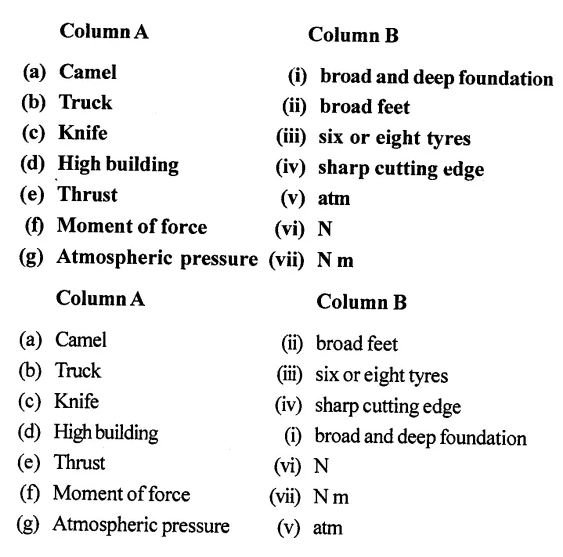
4. Select the correct alternative
(a) SI. unit of moment of force ¡s
- N
- N cm
- kgfm
- N m
Answer
Nm
(b) To obtain a given moment of force for turning a body, the force needed can be decreased by
- applying the force at the pivoted point
- and applying the force very close to the pivoted point
- applying the force farthest from the pivoted point
- none of the above
Answer
applying the force farthest from the pivoted point
(c) The unit of thrust is
- kgf
- kg
- g
- m s-1
Answer
kgf
(d) The unit of pressure is
- N × m
- kgf
- N m-2
- kgf m2
Answer
N m-2
e) The pressure and thrust are related as
- Pressure = Thrust
- and Pressure = Thrust x Area
- so Pressure = Thrust / Area,
- hence Pressure = Area / Thrust
Answer
Pressure = Thrust / Area,
(f) A body weighing 5 kgf, placed on a surface of area 0.1 m2, exerts a thrust on the surface equal to
- 50 kgf
- 5 kgf
- 50 kgf m-2
- 5 kgf m-2
Answer
5 kgf
P.Q. A body weighing 5 kgf, placed on a surface of area 0.1 m2, exerts a pressure on the surface equal to
- 50 kgf
- 5 kgf
- 50 kgf m-2
- 5 kgf m-2
Answer
50 kgf m-2
(g) The feet of lizards act like
- moving pads
- drilling pads
- suction pads
- none of the above
Answer
suction pads
(h) Pressure exerted by a liquid is due to its
- weight
- mass
- volume
- area
Answer
weight
(i) Pressure inside a liquid increases with :
- increase in depth
- decrease in depth
- decrease in density
- none of the above
Answer
increase in depth
(j) The atmospheric pressure at sea level is nearly
- 10 Pa
- 100,000 Pa
- 100 Pa
- 10,000 Pa
Answer
100,000 Pa
(k) Nose bleeding may occur at a high altitude because
- the atmospheric pressure decreases
- the oxygen content of atmosphere decreases
- the atmospheric pressure increases
- there are strong air currents at the high altitude
Answer
the atmospheric pressure decreases
Selina solutions for Concise Physics Class 8 ICSE Chapter 3 Force and Pressure
Short / Long Answer Question
Page-56
Question-1
Define force. State its S.I. unit.
Answer-1
Force is a physical cause that changes or may tend to change the state of rest or the state of motion of an object. The S.I. unit of force is Newton.
Question-2
State two effects of a force when applied on a body.
Answer-2
Two effects of a force when applied :
(i) It can change the state of body.
i.e. It can stop a moving object and also a force can move a stationary object.
(ii) A force can change the shape (and size) of an object.
Question-3
(a )How does the effect of force differ when it is applied on a rigid body?
(b) How does the effect of force differ when it is applied on a non-rigid body?
Answer-3
(a )When a force applied on a rigid object it does not change the interspacing of constituent molecules and does not change dimensions and can cause motion in it.
(b) When a force is applied on a non-rigid object it changes interspacing between its constituent particle and causes a change in its dimensions and can produce motion in it.
Question-4
(a) State the effect of force F in of the following diagram.
(b) State the effect of force F in of the following diagram

Answer-4
(a) The ball moves in the direction of magnitude of force f and continues to move in that direction
(b) Wheel turns about the axis of rotation i.e. about pivot on applying force.
Question-5
Define the term moment of force.
Answer-5
Moment of force — The turning effect of force acting on a body about an axis is called the moment of force.
Question-6
State the S.I. unit of moment of force.
Answer-6
S.I. units : N m (Newton meter)
Question-7
State two factors on which affect moment of force.
Answer-7
- The magnitude of the force applied.
- The distance of the line of action of the force from the axis of rotation.
Page-57
Question-8
In Fig 3.33. a force F is applied in a direction passing through the pivoted point O of the body. Will the body rotate? Give reason to support your answer.

Answer-8
No, the body will not rotate as
Turning effect = Force x ⊥ of the force from the pivoted point.
= Fx 0 = 0
⊥ distance = O or force is parallel to the point of application of force.
Question-9
Write the expression for the moment of force about a given axis of rotation
Answer-9
Moment of force about a given axis = (Force \times) perpendicular distance of force from the axis of rotation.
Question-10
State one way to decrease the moment of a given force about a given axis of rotation.
Answer-10
Either decrease the force or decrease the perpendicular distance of force from the axis of rotation.
Increase the perpendicular distance of force from axis of rotation.
Question-11
State one way to obtain greater moment of a given force about a given axis of rotation.
Answer-11
Moment of a force is the product of the force and the perpendicular distance of force from axis of rotation. So, one way to increase the moment would be to increase the distance from the axis of rotation where the force would act.
Question-12
What do you mean by the clockwise and anti-clockwise moment of force?
Answer-12
Clockwise moment of force — When the moment of force is in the clockwise direction.
Anticlockwise moment — When the moment of force acts in an anticlockwise direction
Question-13
explain the following
(a) The spanner (or wrench) has a long handle.
(b) The steering wheel of a vehicle is of large diameter.
(c) The hand flour grinder is provided with a handle near the rim.
(d) It is easier to open the door by pushing it at its free end.
(e) A potter turns his wheel by applying a force through the stick near the rim of wheel.
Answer-13
(a) Spanner has a long handle to produce larger turning moments when a small force is applied at the handle end.
(b) The steering wheel is of large diameter to decrease the amount of force required to produce the turning effect.
(c) The stone of hand flour grinder is provided with a handle near the rim, i.e. at maximum distance from centre so that it can be easily rotated about the iron pivot at its centre by applying small force at the handle.
(c) It is easier to open the door by applying force at its free end because the increased perpendicular distance decreases the amount of force required to open the door as the moment of force is the product of force and the perpendicular distance.
(e) A potter’s wheel has a wheel pivoted at the centre. The potter turns the wheel by means of a stick at the rim of the wheel which increases the perpendicular distance.
Question-14
What is thrust?
Answer-14
Thrust is a force or a push. When a system pushes or accelerates mass in one direction, there is a thrust (force) just as large in the opposite direction.
Question-15
State the unit of thrust
Answer-15
S.I. unit is newton [N].
Question-16
On what factors does the effect of thrust on a surface depend?
Answer-16
The effect of thrust depends on the area of the surface on which it acts. Smaller the area of the surface on which a thrust acts, larger is its effect. But the effect of a thrust is less on a larger area.
Question-17
Define the term ‘pressure’ and state its unit.
Answer-17
PRESSURE : “The thrust on unit area of the surface is called PRESSURE.”
Pressure = Thrust / Area
S.I. unit = Nm-2
Question-18
How is the thrust related to pressure?
Answer-18
Pressure is directly proportional to thrust
i.e. greater the thrust, greater is the pressure and smaller the thrust, smaller is the pressure.
Force simply refers to push or pull on an object whereas thrust refers to the reaction force acting on an accelerated object due to the force which is applied to that object. Therefore, the relationship between thrust and pressure is that pressure is directly proportional to thrust.
Question-19
Name two factors on which the pressure on a surface depends.
Answer-19
Factors affecting the pressure :
(i) The surface area (A) on which thrust acts. More area, lesser is pressure. (Area)
(ii) The magnitude of thrust (F) acting on the surface. (Force)
∵ P = Thrust/Area = F/A
More thrust more is pressure.
Question-20
When does a man exert more pressure on the floor: while standing or while walking?
Answer-20
Pressure is inversely proportional to area. P = F/A
While walking, one foot is in contact with the ground at a time. The surface area of one foot is less than two feet. Therefore, the pressure is more than the pressure exerted while standing, as the surface area of both feet is more.
Question-21
Why do camels or elephants have broad feet?
Answer-21
Camels have to walk on sand. To walk fast, the feet should not sink in sand, the feet area broad i.e. increase in area. Hence, lesser pressure will help to sink less and so camels have broad feet.
Elephants have broad feet in proportion to their size. Because of their weight and size, elephants need to distribute the weight better.
Question-22
A sharp pin works better than a blunt pin. Explain the reason.
Answer-22
A sharp tip is provided at the end of a pin so that pressure (FORCE / AREA) exerted by it is maximum when it is pressed by a given force.
Question-23
Why is the bottom part of the foundation of a building made wider?
Answer-23
P ∝ 1/A i.e. pressure is inversely proportional to surface Area
Greater the area, lesser is the pressure.
In order that building should exert less pressure, the foundation of the building should have more area or be wider. So that building should not sink into the earth.
Question-24
It is easier to cut with a sharp knife than with a blunt one. Explain
Answer-24
It is easier to cut with a sharp knife than with a blunt one because, for the same applied force, the pressure exerted (force/area) is more in the case of the sharp knife than in the case of a blunt one
Question-25
A gum bottle rests on its base. If it is placed upside down, how does
(i) the thrust .
(ii) pressure change?
Answer-25
(i) A gum bottle has a narrow neck and wider base. When placed upside down, surface area is less, therefore larger is the effect of thrust.
(ii) A gum bottle has a narrow neck and wider base. When placed upside down, surface area is less, therefore larger is the pressure.
Question-26
explain the following
(a) Sleepers are used below the rails.
(b) A tall building has wide foundations.
Answer-26
(a) Sleepers are used below the rails because they increase the area, and hence reduce the pressure on the ground as pressure and area are inversely proportional. P = F / A
(b) Pressure is inversely proportional to area of the surface. Hence greater the area, lesser the pressure.
For the building to exert less pressure on the ground and not sink into the earth, the foundation of the building should have a wider area.
Question-27
describe an experiment to show that liquid exert pressure on the bottom of container which it kept
Answer-27

Procedure – Take a balloon and tie it at the lower end of a glass tube and hold vertically as in figure (a). Pour some water in the tube, balloon bulges out as in fig (b) because the water column exerts pressure at its bottom.
Observation – Force on the balloon is equal to the weight of the water column which is called Thrust. Also, pressure exerted by the water P = Thrust/Area of bottom of the tube.
This shows that a liquid exerts pressure at the bottom of the container in which it is kept.
Question-28
describe a suitable experiment to demonstrate that liquid exert pressure sidewise also
Answer-28
To show – A liquid exerts pressure sideways
Procedure – Set up the apparatus as shown in figure.
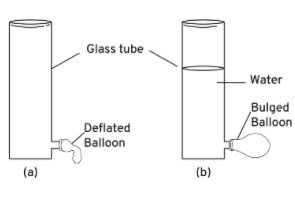
A deflated balloon is tied up on the side tube of a container opened at one side. Now fill water in the container, balloon connected inflates due to pressure of liquid exerted sideways.
Observation – This shows that liquids exerts pressure sideways also.
Question-29
describe a simple experiment to show that at a given depth a liquid exert same pressure in all direction
Answer-29
To show – A liquid exerts same pressure in all directions, at a given depth.
Procedure – We have often seen children playing with polythene bags filled with water and have small holes at various places on this bag and sprinkling water on others. This is because water enclosed in bags exerts pressure in all directions.
Question-30
state two factor on which the pressure at a point depend
Answer-30
The pressure at a point is given by P = gh
Where is the density of the liquid,
g is the acceleration due to gravity, and
h is the depth of the point below the liquid’s surface.
Question-31
Describe an experiment to show that the liquid pressure at a point increases with the increase in height of the liquid column above that point.
Answer-31
To show – the liquid pressure at a point increases with the increase in height of the liquid column above that point.
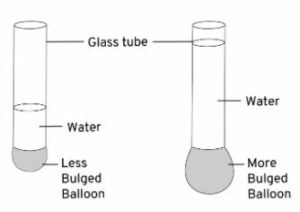
Procedure – Tie a balloon at one end of a glass tube opened at both ends. Pour some water and note the bulging of balloon as in
Now add more water in the tube, bulging also increases. Adding more water to the tube increases bulging further as liquid pressure at a point increases with increase in height of the liquid column above that point.
Question-32
Which fact about liquid pressure does the diagram in figure illustrate?
Answer-32
The figure shows that the liquid pressure increases with the height of the liquid column above it.

Question-33
Describe an experiment to show that liquid pressure depends on the density of liquid.
Answer-33
To show – Liquid pressure depends on the density of liquid
Procedure – Take two identical balloons attached to one end of each of two identical glass tubes opened at both ends
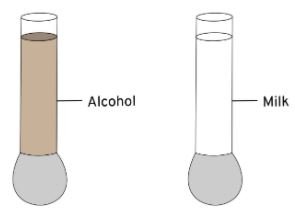
Fill one tube with milk and another with alcohol to the same height.
Observation – It can be seen that the balloon attached to the tube with milk bulges out more than the balloon attached to the tube with alcohol.
This shows that the same height of milk exerts more pressure than alcohol. Since the density of milk (1.03) is more than the density of alcohol (0.8).
Question-34
A dam has broader walls at the bottom than at the top. Give a reason.
Answer-34
A dam has broader walls at the bottom than at the top to withstand the great pressure of water which increases with increase in depth.
Question-35
What do you mean by atmospheric pressure?
Answer-35
The thrust due to atmospheric air acting per unit area of land is called atmospheric pressure.
Question-36
Write the numerical value of the atmospheric pressure on the earth surface in pascal.
Answer-36
100 K Pa
Question-37
We do not feel uneasy even under the enormous atmospheric pressure. Give a reason.
Answer-37
We do not feel uneasy even under the enormous atmospheric pressure because blood in our body exerts blood pressure which is slightly more than atmospheric pressure.
Page-58
Question-38
Describe a simple experiment to illustrate that air exerts pressure.
Answer-38
To show – Air exerts pressure
Procedure – Take a tin-can having an air tight cap (screw cap). Remove the cap and boil some water in it, so that steam comes out and in this way air from inside goes out. While boiling replace the cap and allow it to cool. Vapours inside condense and form water creating vacuum above them.

Observation – The can crumbles due to air pressure from outside. This proves that air exerts pressure.
Question-39
Describe the crushing tin can experiment. What do you conclude from this experiment?
Answer-39
Take a tin-can having an air tight cap (screw cap). Remove the cap and boil some water in it, so that steam comes out and in this way air from inside goes out. While boiling replace the cap and allow it to cool. Vapours inside condense and form water creating vacuum above them. The can crumbles due to air pressure from outside. This proves that air exerts pressure.
Question-40
Give reason for the following:
(a) A balloon collapses when air is removed from it.
(b) Water does not run out of a dropper unless its rubber bulb is pressed.
(c) Two holes are made in a sealed oil tin to take out oil from it.
Answer-40
(a) The atmospheric pressure of the air outside the balloon is more than the inside pressure of the balloon which causes it to collapse.
(b) Atmospheric pressure acting from outside the dropper balances the pressure exerted by water and water does not come out of a dropper. On pressing the dropper, the pressure inside becomes more than outside atmospheric pressure and water runs out.
(c) Two holes are made in a sealed tin so that atmospheric air presses the oil at one one hole and oil comes out of the second hole.
Question-41
How does the atmospheric pressure change with altitude?
Answer-41
The atmospheric pressure varies with altitude as density of air decreases as we rise up and air becomes rarer. For example: Pressure at sea level is taken as 76 cm of Mercury Column, which is one atmosphere. For every 105m rise in height, pressure decreases by 1 cm of mercury column
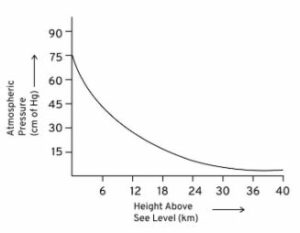
Numericals Class-8 Chapter-3 Force and Pressure ICSE Class-8th Concise Selina Physics Solutions
Page-58
Question-1
Find the moment of force of 20N about an axis of rotation at distance 0.5m from the force.
Answer-1
F = 20 N ⊥ distance = 0.5 m
Moment of force = Force x perpendicular distance of force from the point of rotation
= F x ⊥ distance
= 20 N × 0.5 m
= lO Nm
Question-2
The moment of a force of 25 N about a point is 2.5 N m. Find the perpendicular distance of force from that point
Answer-2
Moment of force = 2.5 N m
Force applied = 25
⊥ distance from the point of rotation ?
Moment of force = Force × ⊥ distance
2.5 = 25 × χ
∴ x= ⊥ distance = 2.5/ 25= 1/ 10 m
= (1/10) × 100 = 10cm
Question-3
A spanner of length 10 cm is used to open a nut by applying a minimum force of 5.0 N. Calculate the moment of force required.
Answer-3
⊥ Distance = 10cm = 10/100 = 1/10 m
Force applied on spanner 5 N
∴ Moment of force = F ×⊥ distance
= 5 × 1/10 = 0.5 nm.
Question-4
A wheel of diameter 2 m can be rotated about an axis passing through its center by a moment of force equal to 2.0 N m. What minimum force must be applied on its rim?
Answer-4
Diameter (perpendicular distance) = 2 m
Moment of force = 2 Nm
Force =?
moment of force = diameter × force
Force = moment of force / diameter
Force = 2Nm / 2m
Force = 1N.
Question-5
A normal force of 200 N acts on an area of 0.02 m2. Find the pressure in pascal.
Answer-5
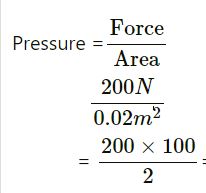
= 1000 n/m²
Question-6
Find the thrust required to exert a pressure of 50000 pascals on an area of 0.05 m2 ?
Answer-6
Pressure = Force / Area
Force = Pressure × Area
= 50,000 x 0.05 = 2,500 Newton
Question-7
Find the area of a body which experiences a pressure of 50000 Pa by a thrust of 100 N?
Answer-7
Pressure on the body = 50,000 pa
Force or thrust = 100 N
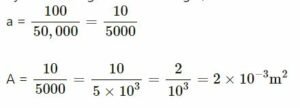
Calculate the pressure in pascal exerted by a force of 300 N acting normally on an area of 30 cm2.
Answer-8

Question-9
How much thrust will be required to exert a pressure of 20,000 Pa on an area of 1 cm2.
Answer-9
Pressure =20,000 Pa
Area = 1 cm2
= 10-4 m2
Force = Pressure × area
=20,000 x 10-4 = 2 Newton
Question-10
The base of a container measures 15 cm × 20 cm. It is placed on a table top. If the weight of the container is 60 N, what is the pressure exerted by the container on the table top?
Answer-10
Area of the base of container
Area of the base of container
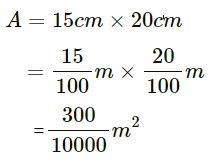
Force = weight = 60N

Question-11
Calculate the pressure exerted on a surface of 0.5 m2 by a thrust of 100 kgf.
Thrust (F) = 100 kgf
A = 0.5 m2

= 60 x 10 = 600 N
Area of platform = 2.5 cm x 0.5 cm


Weight of bricks = F = 2kgf
(a)


(b)
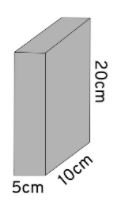
Area of base = Area of top = 5 cm \times 10 cm = 50 cm^2
Pressure = Force/Area
area of base = area of top
= 5 cm × 10 cm = 50 cm2
Pressure exerted = P = F / A
=2 kgf / 50 cm2
=0.04
P = 0.04 kgf cm-2
(c)

Area of base = Area of top = 5 cm \times 20 cm = 100 cm^2
Pressure = Force/Area
Weight of brick
F = 2 kgf
Area of base = L × B
= 20 cm × 5 cm = 100 cm2
Pressure exerted = F / A
= 2 / 100
= 0.02 kgf cm-2
Return to- ICSE Class -8 Selina Concise Physics Solutions
Thanks
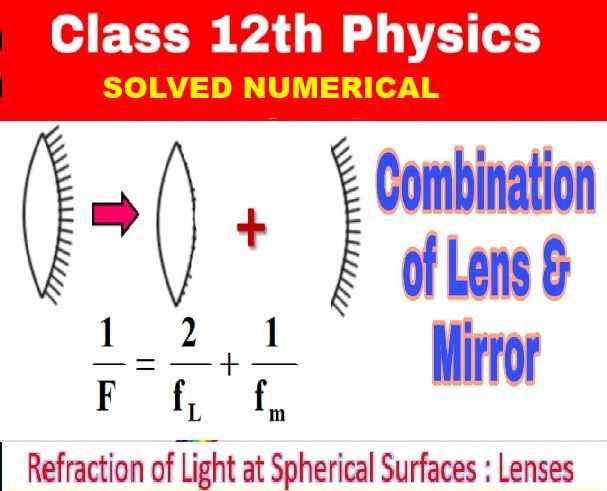
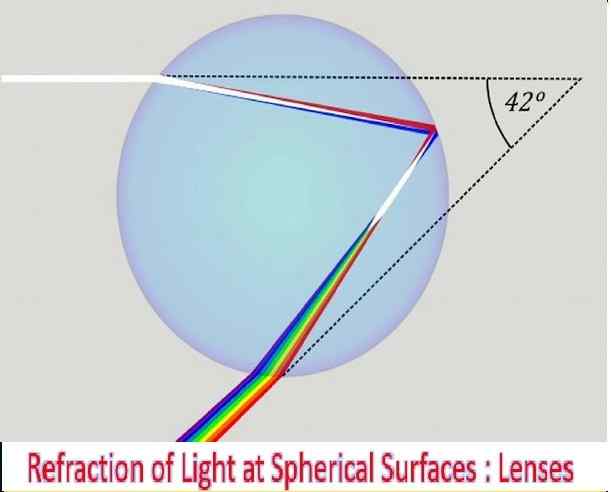
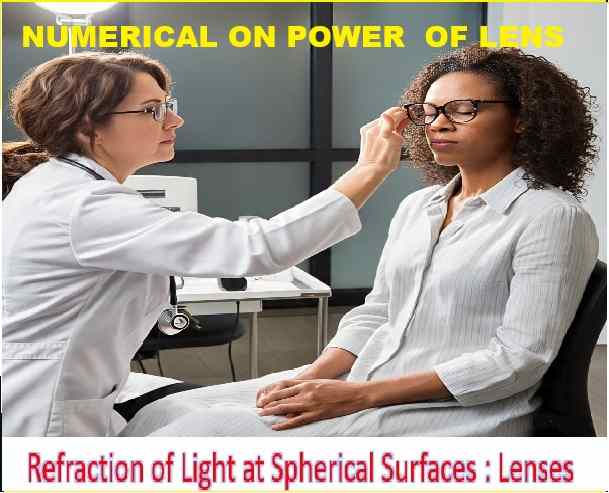
It is actually very helpful, tomorrow is my test and i am revising from this only
Thanks
if feel any difficulty in test preparation immediate contact without hesitation
Team ICSE Help
I teach my son from this. Thankyou so much.
Thanks it’s very helpful for me,my exam will start from Monday and I’m preparing all questions answers and numerical solve from this
ok